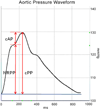Central aortic pressure is independently associated with diastolic function
- PMID: 20569723
- PMCID: PMC2913412
- DOI: 10.1016/j.ahj.2010.02.024
Central aortic pressure is independently associated with diastolic function
Abstract
Background: Studies investigating the association between central aortic pressures and diastolic function have been limited.
Methods: Consecutive ambulatory patients (n = 281, mean age 49 +/- 13 years, 49% male) with normal left ventricular (LV) systolic function were included. The LV filling pressure (E/Em) was estimated by Doppler-derived ratio of mitral inflow velocity (E) to septal (Em) by tissue Doppler, LV relaxation by Em, and central aortic pressures by radial tonometry. Central aortic systolic (cSBP), diastolic (cDBP), mean (cMAP) and pulse pressure (cPP) were entered individually into stepwise linear regression models to determine their association with E/Em or Em.
Results: In univariate analysis, cPP correlated most strongly with E/Em (Spearman's rho = 0.45, P < .001), whereas cSBP correlated most strongly with Em (Spearman's rho = -0.51, P < .001). Multivariate analysis demonstrated that the pulsatile component of afterload, cPP, contributed most to E/Em (partial r(2) = 23%); meanwhile, the nonpulsatile components (cDBP and cMAP) were significant but small contributors (partial r(2) of 6% and 5%, respectively) of LV relaxation (Em).
Conclusion: The nonpulsatile components of aortic afterload (cMAP and cDBP) exhibited a weak but significant association with LV relaxation, whereas the pulsatile component of afterload, cPP, exhibited strong association with LV filling pressure.
Copyright 2010 Mosby, Inc. All rights reserved.
Conflict of interest statement
Figures


Similar articles
-
Influence of alterations in loading on mitral annular velocity by tissue Doppler echocardiography and its associated ability to predict filling pressures.Chest. 2004 Dec;126(6):1910-8. doi: 10.1378/chest.126.6.1910. Chest. 2004. PMID: 15596692
-
Increased aortic pressures and pulsatile afterload components promote concentric left ventricular remodeling in adults with transposition of the great arteries and arterial switch operation.Int J Cardiol. 2024 Jun 15;405:131969. doi: 10.1016/j.ijcard.2024.131969. Epub 2024 Mar 14. Int J Cardiol. 2024. PMID: 38490269
-
Assessment of left ventricular systolic and diastolic function by Doppler tissue imaging in patients with preinfarction angina.J Am Soc Echocardiogr. 2003 Oct;16(10):1024-30. doi: 10.1016/S0894-7317(03)00552-2. J Am Soc Echocardiogr. 2003. PMID: 14566294
-
Non-invasive assessment of left ventricular filling pressure.Eur J Heart Fail. 2018 Jan;20(1):38-48. doi: 10.1002/ejhf.971. Epub 2017 Oct 8. Eur J Heart Fail. 2018. PMID: 28990316 Review.
-
Clinical aspects of left ventricular diastolic function assessed by Doppler echocardiography following acute myocardial infarction.Dan Med Bull. 2001 Nov;48(4):199-210. Dan Med Bull. 2001. PMID: 11767125 Review.
Cited by
-
Effects of sodium thiosulfate on vascular calcification in end-stage renal disease: a pilot study of feasibility, safety and efficacy.Am J Nephrol. 2011;33(2):131-8. doi: 10.1159/000323550. Epub 2011 Jan 17. Am J Nephrol. 2011. PMID: 21242673 Free PMC article. Clinical Trial.
-
Left atrium volume index is influenced by aortic stiffness and central pulse pressure in type 2 diabetes mellitus patients: a hemodynamic and echocardiographic study.Med Sci Monit. 2013 Mar 4;19:153-64. doi: 10.12659/MSM.883818. Med Sci Monit. 2013. PMID: 23458774 Free PMC article.
-
Clinical significance of central systolic blood pressure in LV diastolic dysfunction and CV mortality.PLoS One. 2021 May 5;16(5):e0250653. doi: 10.1371/journal.pone.0250653. eCollection 2021. PLoS One. 2021. PMID: 33951046 Free PMC article.
-
Relations of Central Hemodynamics and Aortic Stiffness with Left Ventricular Structure and Function: The Framingham Heart Study.J Am Heart Assoc. 2016 Mar 25;5(3):e002693. doi: 10.1161/JAHA.115.002693. J Am Heart Assoc. 2016. PMID: 27016574 Free PMC article.
-
Differential response of central blood pressure to isometric and isotonic exercises.Sci Rep. 2014 Jun 25;4:5439. doi: 10.1038/srep05439. Sci Rep. 2014. PMID: 24961818 Free PMC article.
References
-
- Franklin SS, Khan SA, Wong ND, Larson MG, Levy D The Framingham Heart Study. Is Pulse Pressure Useful in Predicting Risk for Coronary Heart Disease? Circulation. 1999;100(4):354–360. - PubMed
-
- Sesso HD, Stampfer MJ, Rosner B, Hennekens CH, Gaziano JM, Manson JE, et al. Systolic and Diastolic Blood Pressure, Pulse Pressure, and Mean Arterial Pressure as Predictors of Cardiovascular Disease Risk in Men. Hypertension. 2000;36(5):801–807. - PubMed
-
- Benetos A, Safar M, Rudnichi A, Smulyan H, Richard J-L, Ducimetiere P, et al. Pulse Pressure : A Predictor of Long-term Cardiovascular Mortality in a French Male Population. Hypertension. 1997;30(6):1410–1415. - PubMed
-
- Chae CU, Pfeffer MA, Glynn RJ, Mitchell GF, Taylor JO, Hennekens CH. Increased Pulse Pressure and Risk of Heart Failure in the Elderly. JAMA. 1999;281(7):634–643. - PubMed
-
- Mitchell GF, Moye LA, Braunwald E, Rouleau J-L, Bernstein V, Geltman EM, et al. Sphygmomanometrically Determined Pulse Pressure Is a Powerful Independent Predictor of Recurrent Events After Myocardial Infarction in Patients With Impaired Left Ventricular Function. Circulation. 1997;96(12):4254–4260. - PubMed
Publication types
MeSH terms
Grants and funding
LinkOut - more resources
Full Text Sources
Miscellaneous

